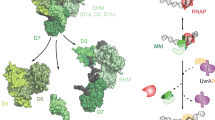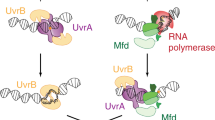Abstract
DNA polymerase IV (pol IV) is expressed at increased levels in Escherichia coli cells that suffer DNA damage. In a recent live-cell single-molecule fluorescence microscopy study, we demonstrated that the formation of pol IV foci is strongly recB-dependent in cells treated with the DNA break-inducing antibiotic ciprofloxacin. The results of that study support a model in which pol IV acts to extend D-loop structures during recombinational repair of DNA double-strand breaks. In the present study, we extend upon this work, investigating the UmuD and UmuDʹ proteins as potential modulators of pol IV activity in ciprofloxacin-treated cells. We found that the non-cleavable mutant UmuD(K97A) promotes long-lived association of pol IV with the nucleoid, whereas its cleaved form, UmuDʹ, which accumulates in DNA-damaged cells, reduces binding. The results provide additional support for a model in which UmuD and UmuDʹ directly modulate pol IV-binding to the nucleoid.


Similar content being viewed by others
References
Burckhardt SE et al (1988) UmuD mutagenesis protein of Escherichia coli: overproduction, purification, and cleavage by RecA. Proc Natl Acad Sci USA 85(6):1811–1815
Churchward G, Belin D, Nagamine Y (1984) A pSC101-derived plasmid which shows no sequence homology to other commonly used cloning vectors. Gene 31(1–3):165–171
Cirz RT et al (2005) Inhibition of mutation and combating the evolution of antibiotic resistance. PLoS Biol 3(6):e176
Frank EG et al (1996) Regulation of SOS mutagenesis by proteolysis. Proc Natl Acad Sci USA 93(19):10291–10296
Ghodke H et al (2019) Spatial and temporal organization of RecA in the Escherichia coli DNA-damage response. Elife 8:9
Godoy VG et al (2007) UmuD and RecA directly modulate the mutagenic potential of the Y family DNA polymerase DinB. Mol Cell 28(6):1058–1070
Henrikus SS et al (2018) DNA polymerase IV primarily operates outside of DNA replication forks in Escherichia coli. PLoS Genet 14(1):e1007161
Henrikus SS et al (2020) Single-molecule live-cell imaging reveals RecB-dependent function of DNA polymerase IV in double strand break repair. Nucleic Acids Res 48(15):8490–8508
Jiang Q et al (2009) The active form of DNA polymerase V is UmuD’(2)C-RecA-ATP. Nature 460(7253):359–363
McDonald JP et al (1998) Intermolecular cleavage by UmuD-like mutagenesis proteins. Proc Natl Acad Sci USA 95(4):1478–1483
Nohmi T et al (1988) RecA-mediated cleavage activates UmuD for mutagenesis: mechanistic relationship between transcriptional derepression and posttranslational activation. Proc Natl Acad Sci USA 85(6):1816–1820
Ponder RG, Fonville NC, Rosenberg SM (2005) A switch from high-fidelity to error-prone DNA double-strand break repair underlies stress-induced mutation. Mol Cell 19(6):791–804
Pribis JP et al (2019) Gamblers: an antibiotic-induced evolvable cell subpopulation differentiated by reactive-oxygen-induced general stress response. Mol Cell 74(4):785-800.e7
Robinson A et al (2015) Regulation of mutagenic DNA polymerase V activation in space and time. PLoS Genet 11(8):e1005482
Rosenberg SM et al (2012) Stress-induced mutation via DNA breaks in Escherichia coli: a molecular mechanism with implications for evolution and medicine. BioEssays 34(10):885–892
Schneider CA, Rasband WS, Eliceiri KW (2012) NIH Image to ImageJ: 25 years of image analysis. Nat Methods 9(7):671–675
Shee C et al (2011) What limits the efficiency of double-strand break-dependent stress-induced mutation in Escherichia coli? J Mol Microbiol Biotechnol 21(1–2):8–19
Shee C, Gibson JL, Rosenberg SM (2012) Two mechanisms produce mutation hotspots at DNA breaks in Escherichia coli. Cell Rep 2(4):714–721
Wagner J et al (2000) The beta clamp targets DNA polymerase IV to DNA and strongly increases its processivity. EMBO Rep 1(6):484–488
Walsh E et al (2019) Role of RNase H enzymes in maintaining genome stability in Escherichia coli expressing a steric-gate mutant of pol VICE391. DNA Repair (Amst) 84:102685
Woodgate R, Ennis DG (1991) Levels of chromosomally encoded Umu proteins and requirements for in vivo UmuD cleavage. Mol Gen Genet 229(1):10–16
Acknowledgements
We would like to thank John P. McDonald for the pJM1243 plasmid and Roger Woodgate for the pRW66 plasmid. We also thank Richard Spinks for helpful discussions. AvO was supported by a Laureate Fellowship FL140100027 from the Australian Research Council. AR was supported by Project Grant APP1165135 from the National Health and Medical Research Council.
Author information
Authors and Affiliations
Corresponding author
Additional information
Communicated by M. Kupiec.
Publisher's Note
Springer Nature remains neutral with regard to jurisdictional claims in published maps and institutional affiliations.
Supplementary Information
Below is the link to the electronic supplementary material.
Rights and permissions
About this article
Cite this article
Henrikus, S.S., van Oijen, A.M. & Robinson, A. Single-molecule fluorescence microscopy reveals modulation of DNA polymerase IV-binding lifetimes by UmuD (K97A) and UmuD′. Curr Genet 67, 295–303 (2021). https://doi.org/10.1007/s00294-020-01134-3
Received:
Revised:
Accepted:
Published:
Issue Date:
DOI: https://doi.org/10.1007/s00294-020-01134-3




